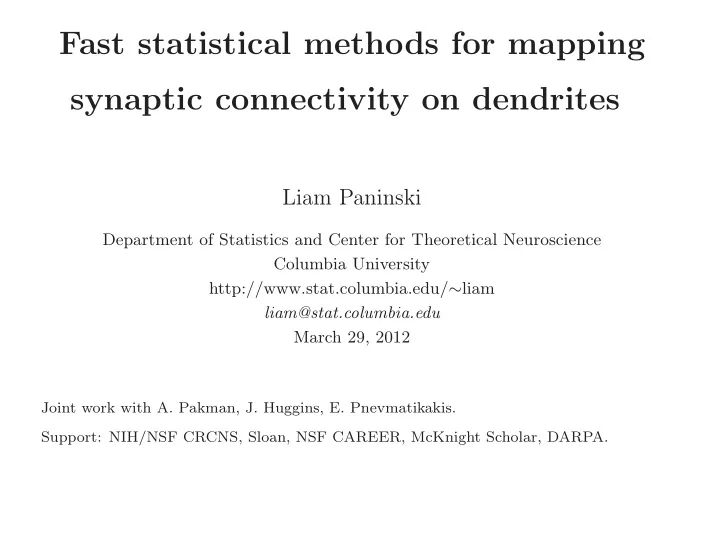

Fast statistical methods for mapping synaptic connectivity on dendrites Liam Paninski Department of Statistics and Center for Theoretical Neuroscience Columbia University http://www.stat.columbia.edu/ ∼ liam liam@stat.columbia.edu March 29, 2012 Joint work with A. Pakman, J. Huggins, E. Pnevmatikakis. Support: NIH/NSF CRCNS, Sloan, NSF CAREER, McKnight Scholar, DARPA.
The coming statistical neuroscience decade Some notable recent developments: • machine learning / statistics methods for extracting information from high-dimensional data in a computationally-tractable, systematic fashion • computing (Moore’s law, massive parallel computing, GPUs) • optical methods for recording and stimulating many genetically-targeted neurons simultaneously • high-density multielectrode recordings (Litke’s 512-electrode retinal readout system; Shepard’s 65,536-electrode active array)
Some exciting open challenges • inferring biophysical neuronal properties from noisy recordings • reconstructing the full dendritic spatiotemporal voltage from noisy, subsampled observations • estimating subthreshold voltage given superthreshold spike trains • extracting spike timing from slow, noisy calcium imaging data • reconstructing presynaptic conductance from postsynaptic voltage recordings • inferring connectivity from large populations of spike trains • decoding behaviorally-relevant information from spike trains • optimal control of neural spike timing — to solve these, we need to combine the two classical branches of computational neuroscience: dynamical systems and neural coding
Basic goal: understanding dendrites Ramon y Cajal, 1888.
The filtering problem Spatiotemporal imaging data opens an exciting window on the computations performed by single neurons, but we have to deal with noise and intermittent observations.
Basic paradigm: compartmental models • write neuronal dynamics in terms of equivalent nonlinear, time-varying RC circuits • leads to a coupled system of stochastic differential equations
Inference of spatiotemporal neuronal state given noisy observations Variable of interest, q t , evolves according to a noisy differential equation (e.g., cable equation): dq/dt = f ( q ) + ǫ t . Make noisy observations: y ( t ) = g ( q t ) + η t . We want to infer E ( q t | Y ): optimal estimate given observations. We also want errorbars: quantify how much we actually know about q t . If f ( . ) and g ( . ) are linear, and ǫ t and η t are Gaussian, then solution is classical: Kalman filter. Extensions to nonlinear dynamics, non-Gaussian observations: hidden Markov (“state-space”) model, particle filtering
Basic idea: Kalman filter Dynamics and observation equations: d� V /dt = A� V + � ǫ t y t = B t � � V + � η t V i ( t ) = voltage at compartment i A = cable dynamics matrix: includes leak terms ( A ii = − g l ) and intercompartmental terms ( A ij = 0 unless compartments are adjacent) B t = observation matrix: point-spread function of microscope Even this case is challenging, since d = dim( � V ) is very large Standard Kalman filter: O ( d 3 ) computation per timestep (matrix inversion) (Paninski, 2010): methods for Kalman filtering in just O ( d ) time: take advantage of sparse tree structure.
Example: inferring voltage from subsampled observations (Loading low-rank-speckle.mp4)
Example: summed observations (Loading low-rank-horiz.mp4)
Applications • Optimal experimental design: which parts of the neuron should we image? Submodular optimization (Huggins and Paninski, 2011) • Estimation of biophysical parameters (e.g., membrane channel densities, axial resistance, etc.): reduces to a simple nonnegative regression problem once V ( x, t ) is known (Huys et al., 2006) • Detecting location and weights of synaptic input
Application: synaptic locations/weights
Application: synaptic locations/weights
Application: synaptic locations/weights Including known terms: d� V /dt = A� V ( t ) + W � U ( t ) + � ǫ ( t ); U ( t ) are known presynaptic spike times, and we want to detect which compartments are connected (i.e., infer the weight matrix W ). Loglikelihood is quadratic; W is a sparse vector. Adapt standard sparse regression methods from machine learning. Total computation time: O ( dTk ); d = # compartments, T = # timesteps, k = # nonzero weights.
Example: toy neuron
Example: toy neuron
Example: real neural geometry
Example: real neural geometry 700 timesteps observed; 40 compartments (of > 2000) observed per timestep Note: random access scanning essential here: results are poor if we observe the same compartments at each timestep.
Work in progress • Combining fast Kalman filter with particle filter to model strongly nonlinear dendrites • Exploiting local tree structure: distant compartments nearly uncoordinated ( → factorized particle filter) • Incorporating calcium measurements (Pnevmatikakis et al., 2011)
Conclusions • Modern statistical approaches provide flexible, powerful methods for answering key questions in neuroscience • Close relationships between biophysics and statistical modeling • Modern optimization methods make computations very tractable; suitable for closed-loop experiments • Experimental methods progressing rapidly; many new challenges and opportunities for breakthroughs based on statistical ideas
References Djurisic, M., Antic, S., Chen, W. R., and Zecevic, D. (2004). Voltage imaging from dendrites of mitral cells: EPSP attenuation and spike trigger zones. J. Neurosci. , 24(30):6703–6714. Huggins, J. and Paninski, L. (2011). Optimal experimental design for sampling voltage on dendritic trees. J. Comput. Neuro. , In press. Huys, Q., Ahrens, M., and Paninski, L. (2006). Efficient estimation of detailed single-neuron models. Journal of Neurophysiology , 96:872–890. Knopfel, T., Diez-Garcia, J., and Akemann, W. (2006). Optical probing of neuronal circuit dynamics: genetically encoded versus classical fluorescent sensors. Trends in Neurosciences , 29:160–166. Paninski, L. (2010). Fast Kalman filtering on quasilinear dendritic trees. Journal of Computational Neuroscience , 28:211–28. Pnevmatikakis, E., Kelleher, K., Chen, R., Josic, K., Saggau, P., and Paninski, L. (2011). Fast nonnegative spatiotemporal calcium smoothing in dendritic trees. COSYNE .
Recommend
More recommend